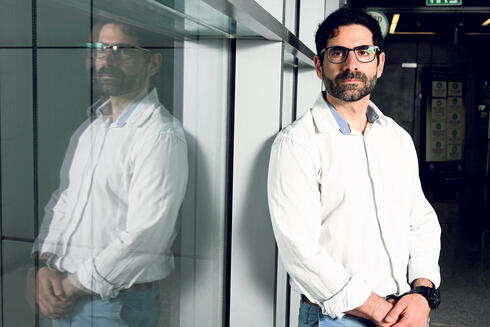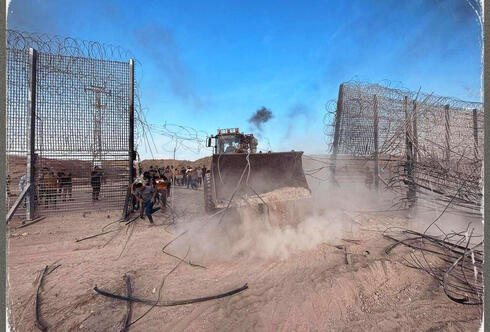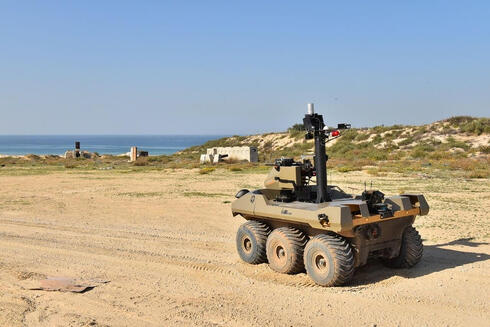
Most Promising Startups - 2025
How Israel’s defense-tech industry rebooted after October 7
Once caught off guard by Hamas, the Defense Ministry is now turning to startups and AI to shape the battlefield of the future.
The October 7 war began with the infiltration of thousands of Hamas terrorists across the “Hourglass” barrier between Gaza and Israel—a high-tech defense project completed two years earlier at a cost of approximately 3.5 billion shekels ($1 billion). By 6:29 that morning, what had been lauded as “a technological and creative project of the highest order” by senior security officials—who believed it would offer unprecedented protection to Israeli communities bordering Gaza—had already begun to unravel.
The barrier stretches roughly 65 kilometers, from Kerem Shalom in the south to Zikim Beach in the north. Its subterranean component consists of a deep concrete wall designed to thwart tunnel digging from Gaza, while the above-ground segment features a smart fence more than six meters high, embedded with cutting-edge surveillance and detection systems.
But on the morning of the attack, the barrier’s fragility was laid bare. Within minutes, it was breached in dozens of locations using explosive charges and bulldozers. Rafael’s remote-controlled defense systems, mounted on dedicated masts and intended to deliver precise, lethal fire against infiltrators, were rendered inoperative by simple drones dropping munitions on them. The "iron wall"—a symbol of bold, outside-the-box security thinking—collapsed.
Dr. Gal Harari, 41, CTO at the Defense Ministry’s Directorate of Defence Research & Development (DDR&D), pushes back on the notion that the rapid failure of the barrier marked the downfall of Israeli defense technologies against what he calls a "primitive" enemy.
Is DDR&D Investigating itself as part of the war inquiries?
“Absolutely,” Harari says. “It’s very difficult to develop new systems if you don’t conduct internal investigations to see what worked and what didn’t. We’re doing that thoroughly.”
Harari declines to elaborate on the specific findings or lessons DDR&D has drawn from the war so far, citing the sensitivity of the issue. But subtle clues may lie in the flurry of activity drawing startups into Israel’s defense ecosystem, as DDR&D searches for fast, innovative responses to wartime challenges—if not for the current conflict, then for the next one.
October 7 Brought Startups into the IDF
A quiet revolution has taken place in how the Ministry of Defense collaborates with civilian entrepreneurs. The scale and nature of the companies now working with the ministry—sometimes comprising only a handful of employees—marks a sharp departure from the pre-war era. Faced with unprecedented operational demands, the defense establishment had little choice but to open its doors.
Just as defense officials now see listening to the startup ecosystem as indispensable during wartime, the ecosystem itself recognizes the opportunity to provide rapid solutions—and gain a foothold in the defense market.
From Q1 2023 to Q4 2024, the number of startups operating under DDR&D programs grew by 72%. Last year alone, about 300 companies received contracts totaling over 1.2 billion shekels. According to Ministry of Defense data, more than 25 startups accelerated from development to production following the outbreak of war. Officials say the conflict has served as a test case for “open innovation” in defense—a model that’s proven itself and is expected to continue expanding in 2025.
This surge coincides with a record spike in global demand for weapons, spurred by ongoing conflicts and a broader arms race. Data from Startup Nation Central published last month underscores the trend: in the past year, the number of Israeli companies active in border security, aerospace, and defense has nearly doubled—from 160 to 312.
“This is a major shift,” says Harari. “No one doubts that, and it opens up enormous opportunities.”
Multidisciplinary Innovation from Outside the System
In wartime, civilian ingenuity has gone into overdrive. In 2024 alone, DDR&D issued seven calls for proposals, receiving over 550 submissions addressing military needs across the board. These included ideas for landing large drones on unstable warship decks, improving combat mental health care, regulating temperatures in field installations, and preventing condensation on optical systems.
“Some of us were skeptical. They asked, ‘What more can be done in these areas that hasn’t already been thought of?’ And then came a flood of high-quality responses,” says Harari. “We connected with dozens of previously unknown companies and received genuinely valuable ideas. Israel’s vibrant ecosystem, especially amid a prolonged war, is providing us with quality input we can act on.”
One successful outcome is an advanced tourniquet system, developed by startup XMetix in response to a DDR&D challenge. Designed by soldiers with battlefield experience, the system enables rapid, autonomous treatment of injuries and reduces human error. It has already saved lives in Gaza and Lebanon.
Another example is a partnership with a Caesarea-based textile company, which is developing camouflage fabrics that reduce the visibility of tanks and armored vehicles while creating optical illusions to mislead enemies.
Other technologies under review touch nearly every aspect of military operations, from dog training to tent setup. For instance, in response to a challenge on climate control, a company proposed a passive cooling paint that reflects more heat than it absorbs, potentially reducing indoor temperatures by several degrees—currently undergoing field trials.
Related articles:
Lowering Barriers for Young Companies
DDR&D recognizes the hurdles faced by young startups, especially regarding defense export regulations.
“These companies need clarity—what they can sell and to whom—because they have to raise capital. But the rules are the same for everyone, big or small,” says Harari. “Still, for a first-time entrepreneur, navigating this can be overwhelming.”
To ease the burden, DDR&D has introduced a “green light” program to help small companies register as suppliers, expedite approvals, and simplify contracts. “We’re trying to bridge these gaps so they can contribute without getting burned,” Harari adds.
Planting the Seeds of the Next Nvidia
In early March, Eyal Zamir succeeded Herzi Halevi as IDF Chief of Staff. Just before, in his prior role as Director General of the Defense Ministry, Zamir launched the ministry’s new Directorate for Artificial Intelligence and Autonomous Vehicles—meant to work alongside legacy directorates overseeing space systems, missile defense, UAVs, and armored platforms.
“The AI directorate responds to a global shift,” says Harari. “In the future, we’ll see semi-autonomous vehicles—combat tools operating independently along borders.”
While the defense-tech sector has grown significantly—accelerated by the Russia-Ukraine war and rising tensions with Iran—Harari is focused on the long-term breakthroughs still to come.
“Deep tech is the next transformational force in security,” he says. “Just as our predecessors built Israel’s original defense industries, deep tech will secure our future. It goes beyond market forces. It requires academic institutions, applied research labs, and major technological bodies. That’s my mission.”
Why Deep Tech Matters
“This field involves the riskiest, most long-term technological bets,” Harari explains. “We’ve identified it as a core gap. Now we’re shaping the Ministry of Defense’s strategy for it. Without state investment, this sector won’t develop on its own.”
He envisions a ripple effect: “Succeed in just one component of this field, and you can build a whole industry around it. That’s how you grow the next Nvidia or Mellanox.”
So—is Israel’s next Nvidia already among the companies working with DDR&D?
“Yes,” Harari says confidently. “I see laser companies with the potential to become giants. These are revolutionary innovations.”
In 2024, the Israel Innovation Authority reported that 8,300 high-tech workers left the country. Does DDR&D feel this brain drain?
“Of course, it’s a sad trend,” says Harari. “But what we’re doing here provides meaningful opportunities—and hope—for many of those people.”
Have any of DDR&D’s own people decided to leave?
“Personally, I haven’t encountered it. And there’s also an opposite trend—people moving to Israel. In our field, people have a strong sense of mission. They understand why they get up every morning. That keeps them here.”


